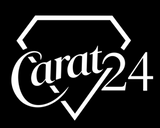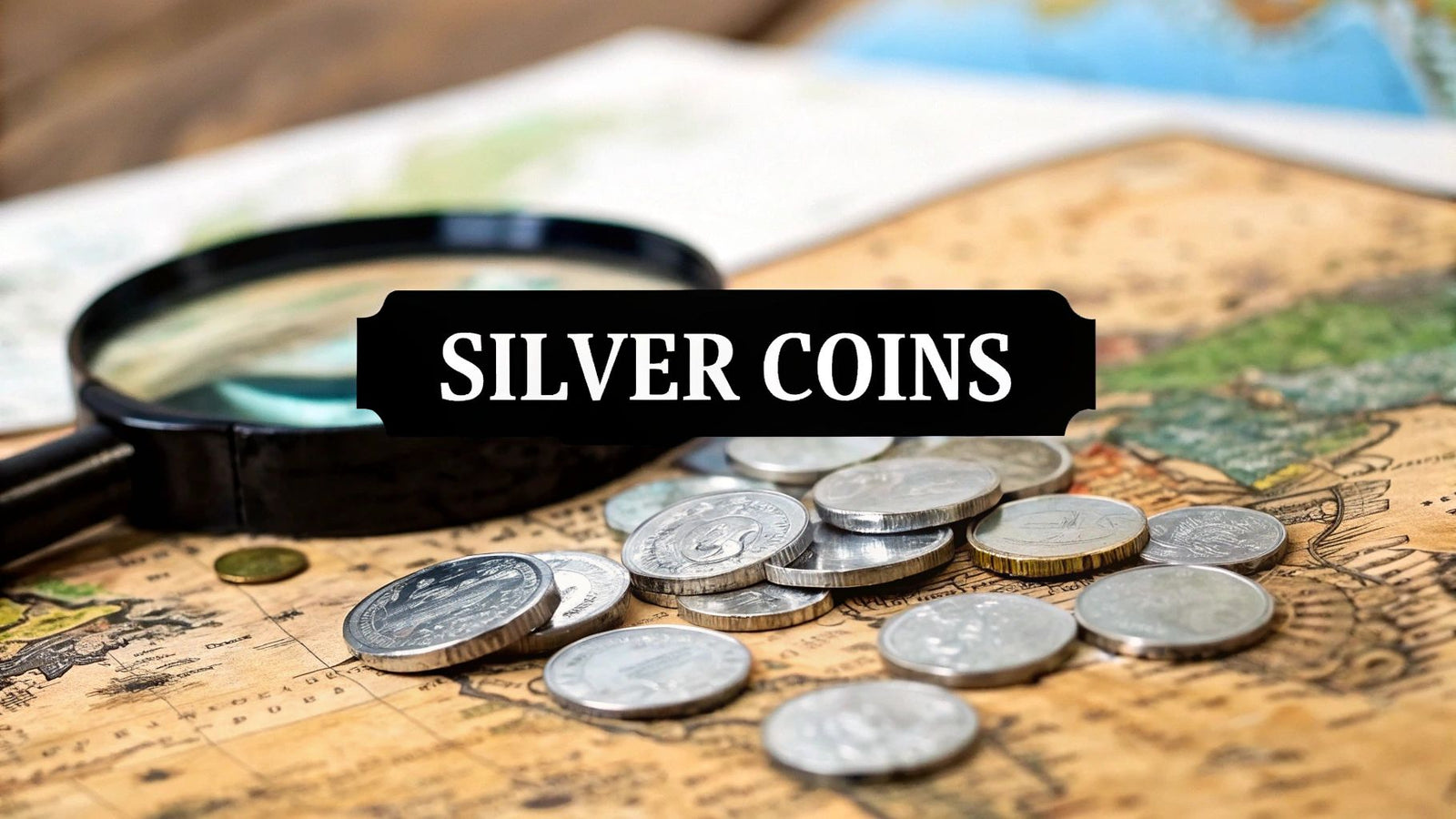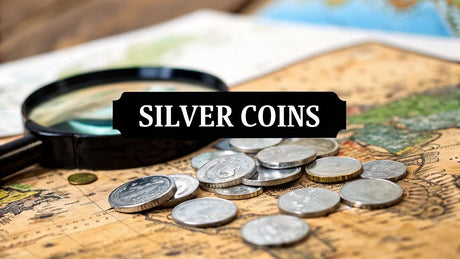Ever found an old, unfamiliar coin rattling in a drawer and wondered if it was just pocket change or something more? It's a common story. Lots of countries, just like the U.S., used to mint their everyday coins from real silver, making them worth much more today than their face value. This guide is your starting point for figuring out what you might have.
Your Guide to Identifying Foreign Silver Coins
Many people stumble across old international coins—maybe in a box from grandpa or a jar of forgotten currency from a trip abroad—without realizing their potential. These aren't just historical curiosities; they are often tangible pieces of precious metal.
Unlike the copper and nickel coins we use today, older international currency frequently contained a hefty percentage of silver. This gives it an intrinsic value based purely on its weight and purity, separate from any collectible appeal.
We'll walk through the essentials of spotting these treasures. We'll look at common examples from places like Canada, Mexico, and Great Britain, focusing on the key dates, designs, and marks that separate valuable silver from common clad coins. The principles are a lot like those for identifying valuable coins from 1964 and earlier in the United States, where that specific year marked the end of silver in most circulating money.
Key Characteristics to Look For
To start your search, just focus on a few simple clues that can point you toward a valuable find:
- Minting Date: Generally, coins minted before the mid-1960s have a much higher chance of being silver. Every country has its own specific cutoff years, so the date is your first big clue.
-
Purity Marks: Some coins make it easy and are stamped with their silver content. Look for small numbers like "
.925" for sterling silver or ".800" for 80% silver. - Distinctive Sound: This one takes a little practice, but it works. When dropped on a hard surface, silver coins produce a high-pitched, bell-like ring. It’s a clean, sharp sound, very different from the dull thud of a modern nickel or zinc coin.
Before we dig deeper, here’s a quick reference table to help you get familiar with some of the most common silver coins you might encounter from around the world.
Quick Guide to Common Foreign Silver Coins
This table highlights key characteristics of popular foreign silver coins to help with quick identification.
| Coin | Country | Common Silver Purity | Key Minting Years |
|---|---|---|---|
| Dollar, Half Dollar, Quarter, Dime | Canada | 80% Silver (pre-1967) | Pre-1967 |
| Un Peso | Mexico | 72% Silver (1957-1967) | 1957-1967 |
| Shilling, Florin, Crown | Great Britain | 92.5% Sterling (pre-1920) | Pre-1920 |
| 5 Francs | France | 90% Silver (pre-1970) | Various years pre-1970 |
| 1, 2, 5 Mark | Germany | 90% Silver (pre-1915) | Pre-1915 |
Keep in mind, this is just a starting point. Many other countries and denominations used silver, but these are some of the heavy hitters you're most likely to find.
Once you think you've found a silver coin, the next step is getting a professional evaluation. If you want to save the hassle and sell locally for more than online shipments, an expert can give you a transparent, accurate assessment. Here at our Boise location, our Gold and Jewelry Buying service offers free Xray Scanning to determine the exact value of your items. We provide straightforward, hassle-free offers and guarantee the highest payout in Boise, even Price Matching to ensure you get the absolute best deal.
The Global Shift Away from Silver Coinage
For centuries, silver wasn't just in money—it was money. But as the 20th century rolled on, something big started to happen. All across the world, nations began pulling precious metals out of the coins people used every day.
This wasn't some random decision. It was a direct response to powerful economic forces that made minting silver coins completely impractical.
The back-to-back World Wars and a massive boom in global industry put incredible pressure on silver supplies. Demand for the metal skyrocketed for new uses in manufacturing, photography, and electronics. Before long, the silver inside a coin was worth more than the number stamped on its face. This created a huge problem for governments: people started hoarding coins for their silver instead of spending them.
Economic Realities Force a Change
When the melt value of a coin climbs past its face value, the whole currency system starts to wobble. Governments were left with a tough choice: either drastically reduce the silver in their coins or get rid of it altogether. Most chose to scrap it.
This change didn't happen overnight or all at once. Different countries hit their tipping point at different times. Great Britain, for example, cut its classic sterling silver (92.5%) coins down to just 50% silver after 1920, then ditched silver completely after 1946.
This was a story that played out across the globe as economic realities set in. You can see these market forces at work by exploring our deep dive into historical silver prices over the last 100 years.
Figuring out if an old foreign coin is one of these valuable silver ones is pretty simple once you know the key things to check.
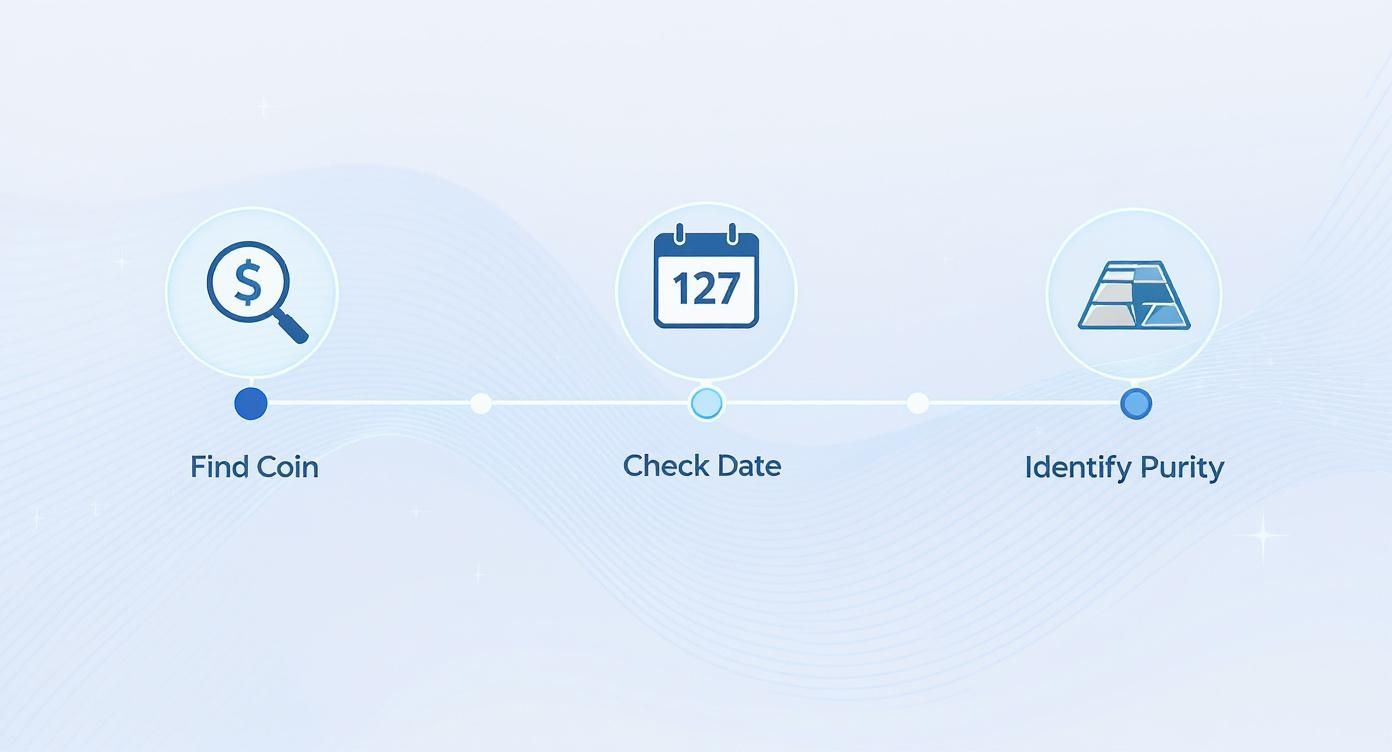
As you can see, the date is always your first clue. That tells you which era the coin belongs to, which then helps you pinpoint its specific silver purity.
A Timeline of Transition
Throughout the 20th century, many major countries were still minting beautiful silver coins for circulation, but the purity levels and cutoff years were all over the map.
- The Royal Canadian Mint, for instance, issued coins with 80% silver purity from 1935 all the way up to 1966.
- Down under, Australia produced sterling silver coins starting in 1910 but had to drop the content to 50% in 1946 because of rising costs.
Understanding this global shift away from silver is key to appreciating why certain foreign coins that are silver hold real value. They are not just collectibles; they are relics from a time when money was directly tied to precious metal.
If you've stumbled upon some old coins from these transitional periods, you could be holding onto something with real value. Save the hassle and sell locally for more than online shipments.
Here at our Boise location, we offer expert Gold and Jewelry Buying services, complete with free Xray Scanning and Gold Testing. We guarantee the highest payout in Boise, with Price Matching and hassle-free offers, so you can be sure you're getting the best possible value for your silver.
Popular Foreign Silver Coins You Might Find
So, you've sifted through an old collection or a travel jar and found some unfamiliar coins. What are you looking at? Let's dive into some of the most common foreign silver coins you're likely to stumble upon. Think of this as your field guide to the usual suspects, from modern bullion made for investors to old, historical coins that were once used as everyday money.
Each one has its own story, its own purpose, and its own value.
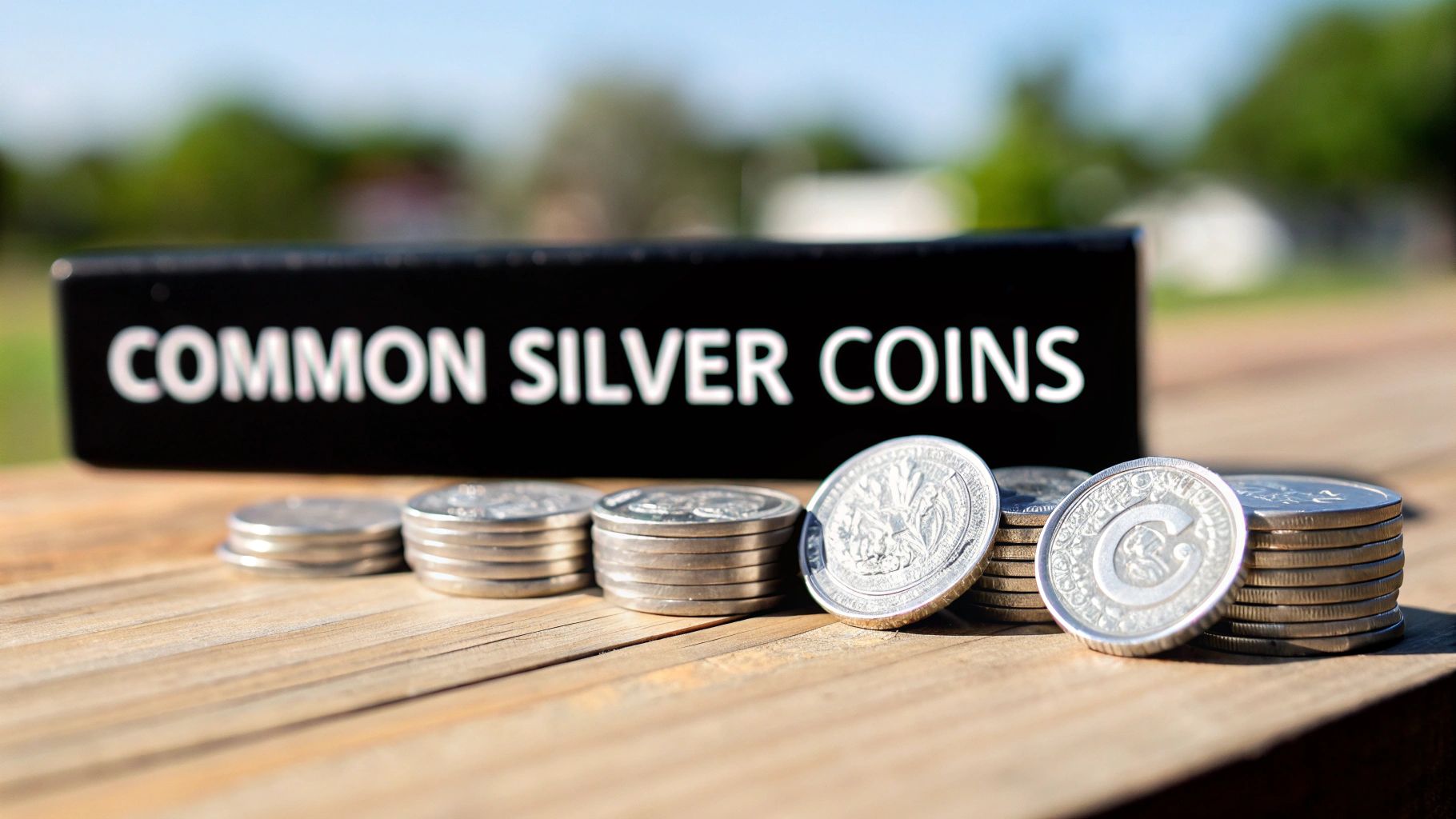
We can pretty much split these coins into two main camps: modern, investment-grade bullion and older, circulated coins often called "junk silver." Bullion coins are fresh from the mint, designed for investors with high purity. Junk silver, on the other hand, is retired currency whose value is now almost entirely based on the precious metal inside it.
Modern Investment Bullion
Modern bullion coins are the heavyweights of the silver stacking world. These are typically one troy ounce of .999 or even .9999 fine silver, which makes figuring out their value a breeze—just check the current spot price of silver. You wouldn't use these to buy groceries; they're made for investing and collecting.
- Canadian Silver Maple Leaf: You can spot this one from a mile away thanks to its iconic maple leaf design. It's famous for its incredible .9999 purity, which is about as pure as it gets. The Royal Canadian Mint started making these in 1988, and they’ve been a staple for silver buyers ever since.
- Mexican Silver Libertad: A personal favorite of many collectors for its gorgeous design featuring the Angel of Independence. The mintage numbers for Libertads can vary wildly from year to year, which makes certain dates extra collectible. They are known for their .999 silver purity.
The global demand for coins like these is staggering. To give you an idea, back in 2019, mints around the world produced about 97.9 million silver coins, with giants like the Royal Canadian Mint leading the charge. You can see the sheer scale of global silver coin production on VisualCapitalist.com.
Historical Circulation 'Junk Silver'
The name 'junk silver' sounds a bit harsh, doesn't it? But for collectors, it’s a term of endearment for a fantastic find: common, circulated coins that don't carry any special numismatic premium. Their value is tied directly to the silver they contain.
Don't let the name fool you. Finding a bag of old foreign 'junk silver' is like discovering a hidden treasure trove, where the value is locked directly into the precious metal itself, immune to inflation.
Countless countries made silver coins for circulation, but here are a couple of the most common ones you might find mixed in with American collections:
- British Pre-1947 Coins: Keep an eye out for old shillings, florins, and crowns. If they're dated before 1920, you've got 92.5% sterling silver. The ones minted between 1920 and 1946 contain 50% silver.
- Canadian Pre-1968 Coins: Our neighbors to the north used 80% silver in their dimes, quarters, half-dollars, and dollars right up until 1967. They briefly dropped the content to 50% in 1967-1968 before switching to other metals. You can learn more about these fascinating pieces in our detailed guide to buying silver coins.
To give you a quick reference, here's a look at some of these coins and what sets them apart.
Popular Foreign Silver Coins and Their Specifications
This table offers a snapshot comparison of some of the world's most popular foreign silver coins, highlighting the differences between modern bullion pieces and their historical, circulated counterparts.
| Coin Name | Country | Typical Silver Purity | Primary Purpose (Bullion/Circulation) |
|---|---|---|---|
| Silver Maple Leaf | Canada | 99.99% (.9999) | Bullion |
| Silver Libertad | Mexico | 99.9% (.999) | Bullion |
| British Shilling | United Kingdom | 92.5% (Pre-1920) / 50% (1920-1946) | Circulation |
| Canadian Quarter | Canada | 80% (Pre-1967) / 50% (1967-1968) | Circulation |
As you can see, the purity and original purpose of a coin tell you a lot about its place in the silver market today. Bullion is prized for its fine silver content, while historical coins offer a tangible piece of history alongside their melt value.
If you have a mixed bag of these coins, the absolute best way to know what you're holding is to bring them to an expert. We specialize in Gold and Jewelry Buying and provide free, hassle-free offers right here in Boise. Our Xray Scanning and Gold Testing services are completely free and non-damaging, guaranteeing you get the highest payout in Boise. We even offer Price Matching, so you can save the hassle and sell locally for more than online shipments.
How to Authenticate Your Foreign Silver Coins at Home
Knowing how to spot the real deal when it comes to foreign coins that are silver is a core skill for any collector. Before you even think about getting a professional opinion, you can build a lot of confidence by running a few simple, non-destructive tests right at home. These quick checks are fantastic for weeding out the obvious fakes from the probable keepers.
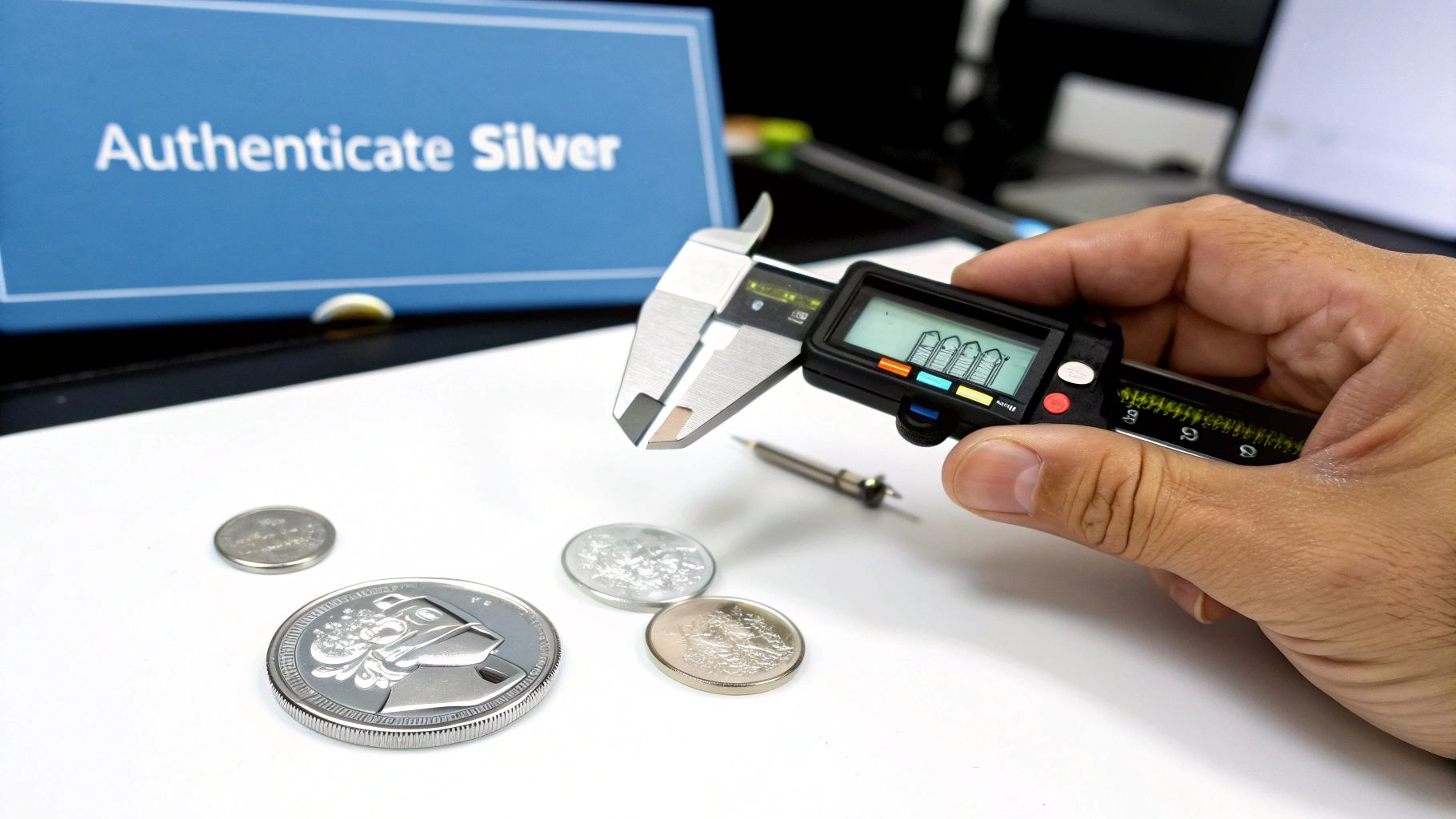
One of the oldest tricks in the book is the "ping test," and it's a classic for a reason. Just balance the coin on the tip of your finger and give it a gentle tap with another coin. A genuine silver coin will sing back to you with a clear, high-pitched, bell-like ring that lingers for a second or two. Base metals like copper or nickel, on the other hand, just give off a dull, lifeless thud. It's a surprisingly reliable gut check.
Simple At-Home Verification Tests
Here's another easy one that requires nothing more than a standard refrigerator magnet. Silver is not magnetic. If your coin snaps to the magnet, that's an immediate red flag—it's definitely not genuine silver. This simple trick is incredibly effective at filtering out counterfeits made with steel.
For those who like to be a bit more precise, it's time to break out the tools and compare your coin against its official mint specs, which you can easily find online.
- Weight: Use a small digital scale. Silver is a dense metal, so a fake will almost always be noticeably lighter or heavier than the official weight. The numbers need to match up.
- Dimensions: Grab a caliper and measure the coin's diameter and thickness. Any significant difference from the mint's published specifications is a major warning sign.
Historically, the sheer volume of silver coinage produced worldwide was staggering, often exploding after major discoveries. For instance, between 1876 and 1920, global silver production quadrupled thanks to huge finds in places like Canada, Mexico, and Australia. You can dive deeper into the history of silver supply on SilverInstitute.org.
The Professional Final Step
While these home tests are great for a first pass, they aren't foolproof. For absolute certainty, especially when you're dealing with a potentially valuable coin, nothing beats a professional evaluation. Our guide on professional authentication walks you through the more advanced methods we use to confirm a coin's legitimacy.
Here at our Boise location, we specialize in Gold and Jewelry Buying, offering expert appraisals you can count on. Why deal with the risk and delay of mailing your items? Save the hassle and sell locally for more than online shipments. We provide free, non-invasive Xray Scanning and Gold Testing to verify your items and give you hassle-free offers. We guarantee the highest payout in Boise and offer Price Matching to ensure you walk away with the best possible value for your foreign silver coins.
Why Selling Silver Locally in Boise Is Your Best Choice
So, you've sifted through your collection and identified some potential treasures. The next step? Turning those foreign silver coins into actual cash. While the internet might throw a bunch of online marketplaces at you, I can tell you from experience that selling locally here in Boise has some serious advantages—saving you time, stress, and often putting more money in your pocket.
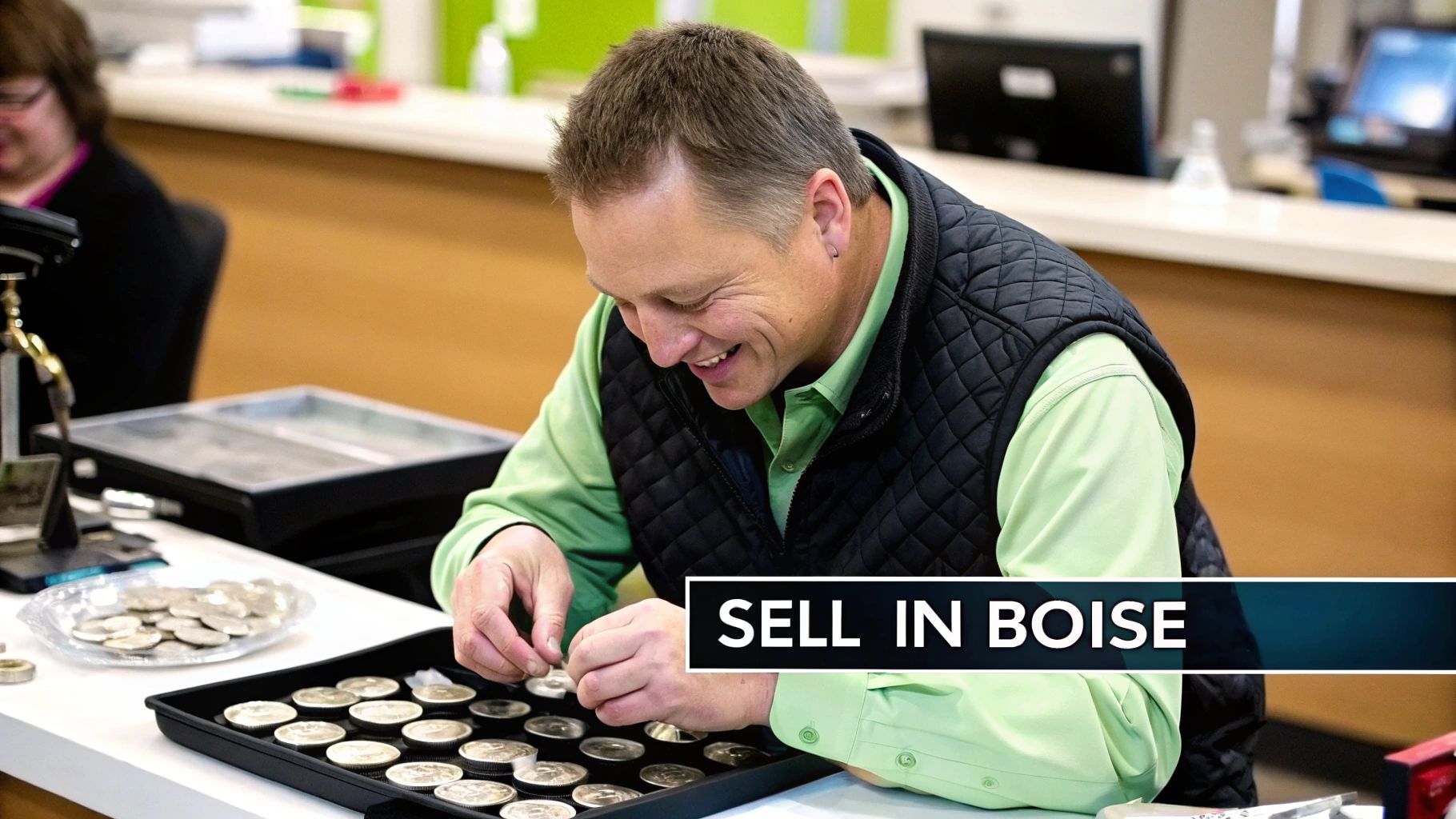
Just think about the hassle of selling online for a minute. You have to become a part-time photographer and copywriter, snapping clear pictures and writing compelling descriptions. Then comes the back-and-forth with strangers, followed by the nerve-wracking process of packaging your valuables and shipping them off, hoping they arrive safely. It’s a real headache.
Save the hassle and sell locally for more than online shipments. A direct, in-person transaction cuts out shipping fees, insurance costs, and that agonizing wait for a payment that might never show up.
When you work with a trusted local Gold and Jewelry Buying expert in Boise, it’s a completely different ballgame. You get a transparent, face-to-face evaluation from a professional who can walk you through the process and answer your questions on the spot.
The Benefits of a Local Expert Evaluation
Choosing a local buyer means you get immediate, professional service without any of the guesswork. Instead of relying on blurry photos or questionable home testing kits, you get access to precise, high-tech equipment for a real assessment.
Here's what we offer, completely free of charge, to make sure you get the best value:
- Free X-ray Scanning and Gold Testing: Our state-of-the-art X-ray fluorescence (XRF) scanners are the real deal. They can tell us the exact metal composition of your coins without leaving so much as a scratch. This scientific accuracy ensures you’re paid for the true silver content, down to the decimal.
- Hassle-Free Offers: We'll evaluate your items right in front of you and give you a straightforward, no-pressure offer. You’re in complete control—there's zero obligation to sell.
- Immediate Payment: If you like our offer, you walk out with cash in hand. No waiting for checks to clear or transfers to process. Simple as that.
Our commitment is to provide the highest payout in Boise, and we back that up with a Price Matching guarantee. If another local competitor gives you a better written offer, bring it in, and we will match it. Selling locally means you not only get a better price but also support our community. If you're weighing your options, our guide on finding places near me that buy gold and silver has even more helpful tips.
Still Have Questions About Foreign Silver Coins?
We get it. Diving into world coins can feel a little overwhelming at first. Here are some straightforward answers to the questions we hear most often from people who've found foreign coins that are silver.
Which Foreign Coins Are Most Likely to Be Silver?
Generally, your best bet is to look at coins minted before the mid-1960s. Countries like Canada, Mexico, Australia, and many European nations are prime candidates.
For example, Canadian dimes, quarters, half-dollars, and even the big silver dollars made before 1968 are packed with silver. Similarly, if you come across British shillings or florins, check the date—anything before 1947 is silver. The trick is knowing that every country stopped using silver at different times, so a quick search on the specific date ranges for each country is key.
How Is the Value of a Foreign Silver Coin Determined?
For most common foreign silver coins, the value comes down to one thing: its "melt value." This is simply the raw value of the silver inside, based on today's market price. It's the baseline worth for well-circulated coins, often called "junk silver."
Now and then, a coin might have extra "numismatic value" if it's exceptionally rare, has historical significance, or is in pristine condition. But for the vast majority of foreign silver found in old jars and collections, its value is almost entirely tied to its silver weight and purity.
Is It Better to Sell Silver Coins Locally or Online?
Selling locally here in Boise is almost always the smarter move. It sidesteps all the risks, steep costs, and headaches that come with shipping valuables to a faceless online buyer. You get a real, in-person appraisal and walk out with payment in hand, instantly.
When you save the hassle and sell locally for more than online shipments, you're choosing security and a better price. Local experts avoid the overhead, shipping, and insurance fees that cut into your profit.
At a professional Gold and Jewelry Buying shop, you'll benefit from transparent tools like free Xray Scanning for a completely hassle-free offer. This process ensures you get the highest payout in Boise, and we even offer Price Matching to guarantee it.
Ready to discover the true value of your coins and jewelry? Visit us at Carat 24 - Trusted Gold Experts for a free, no-obligation evaluation and get the best local offer, guaranteed. Learn more about our services at https://carat24boise.com.
